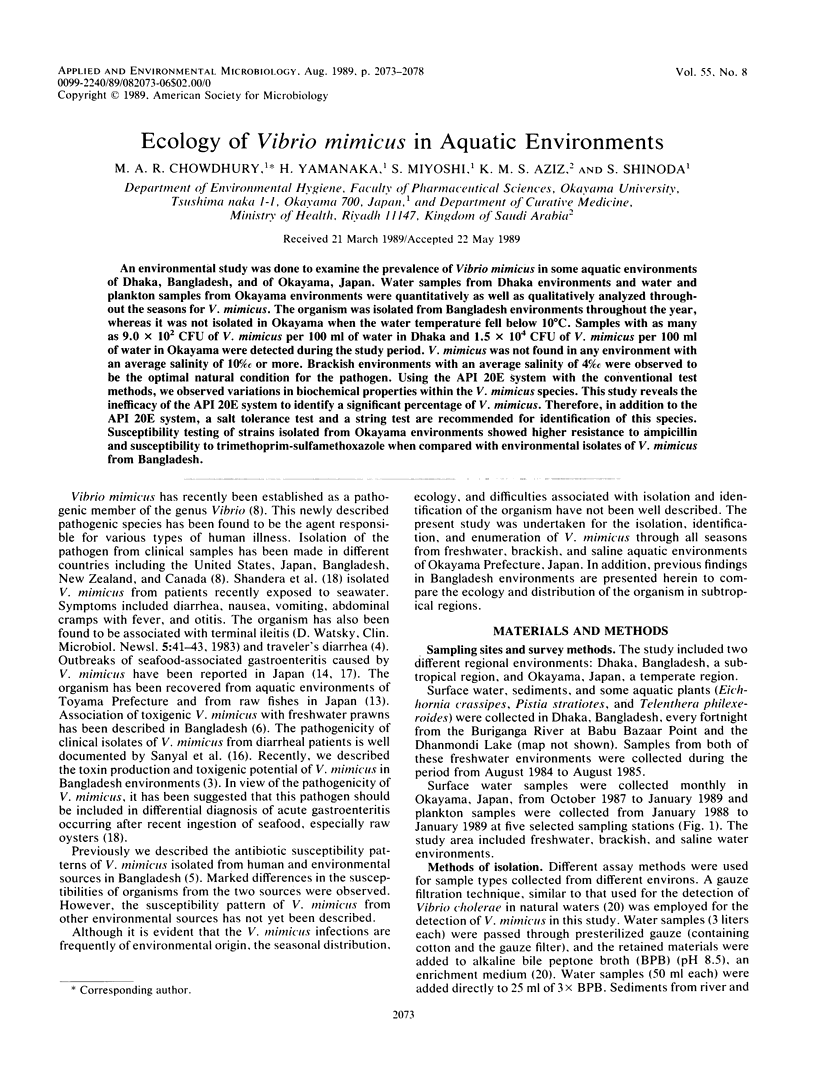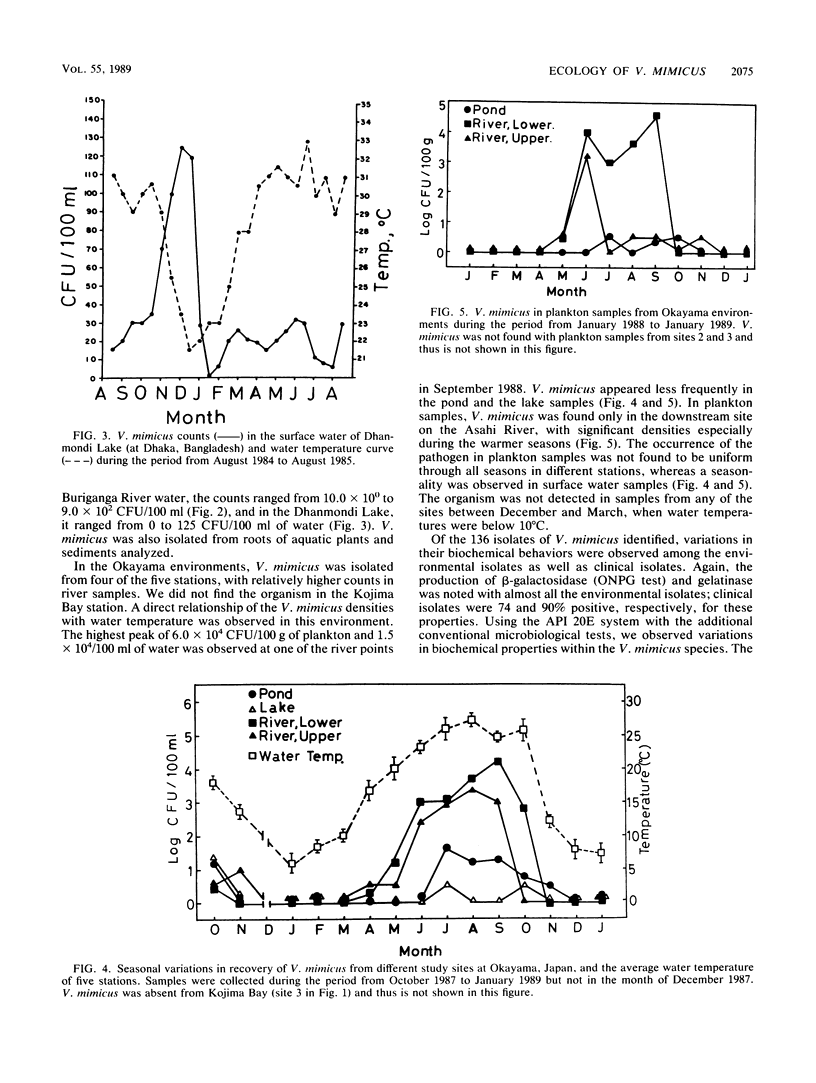Abstract
An environmental study was done to examine the prevalence of Vibrio mimicus in some aquatic environments of Dhaka, Bangladesh, and of Okayama, Japan. Water samples from Dhaka environments and water and plankton samples from Okayama environments were quantitatively as well as qualitatively analyzed throughout the seasons for V. mimicus. The organism was isolated from Bangladesh environments throughout the year, whereas it was not isolated in Okayama when the water temperature fell below 10 degrees C. Samples with as many as 9.0 x 10(2) CFU of V. mimicus per 100 ml of water in Dhaka and 1.5 x 10(4) CFU of V. mimicus per 100 ml of water in Okayama were detected during the study period. V. mimicus was not found in any environment with an average salinity of 10% or more. Brackish environments with an average salinity of 4% were observed to be the optimal natural condition for the pathogen. Using the API 20E system with the conventional test methods, we observed variations in biochemical properties within the V. mimicus species. This study reveals the inefficacy of the API 20E system to identify a significant percentage of V. mimicus. Therefore, in addition to the API 20E system, a salt tolerance test and a string test are recommended for identification of this species. Susceptibility testing of strains isolated from Okayama environments showed higher resistance to ampicillin and susceptibility to trimethoprim-sulfamethoxazole when compared with environmental isolates of V. mimicus from Bangladesh.
Full text
PDF





Selected References
These references are in PubMed. This may not be the complete list of references from this article.
- Bauer A. W., Kirby W. M., Sherris J. C., Turck M. Antibiotic susceptibility testing by a standardized single disk method. Am J Clin Pathol. 1966 Apr;45(4):493–496. [PubMed] [Google Scholar]
- Chowdhury M. A., Aziz K. M., Kay B. A., Rahim Z. Toxin production by Vibrio mimicus strains isolated from human and environmental sources in Bangladesh. J Clin Microbiol. 1987 Nov;25(11):2200–2203. doi: 10.1128/jcm.25.11.2200-2203.1987. [DOI] [PMC free article] [PubMed] [Google Scholar]
- Chowdhury M. A., Aziz K. M., Rahim Z., Kay B. A. Antibiotic resistance patterns of Vibrio mimicus isolated from human and environmental sources in Bangladesh. Antimicrob Agents Chemother. 1986 Oct;30(4):622–623. doi: 10.1128/aac.30.4.622. [DOI] [PMC free article] [PubMed] [Google Scholar]
- Davis B. R., Fanning G. R., Madden J. M., Steigerwalt A. G., Bradford H. B., Jr, Smith H. L., Jr, Brenner D. J. Characterization of biochemically atypical Vibrio cholerae strains and designation of a new pathogenic species, Vibrio mimicus. J Clin Microbiol. 1981 Dec;14(6):631–639. doi: 10.1128/jcm.14.6.631-639.1981. [DOI] [PMC free article] [PubMed] [Google Scholar]
- Holmes B., Willcox W. R., Lapage S. P. Identification of Enterobacteriaceae by the API 20E system. J Clin Pathol. 1978 Jan;31(1):22–30. doi: 10.1136/jcp.31.1.22. [DOI] [PMC free article] [PubMed] [Google Scholar]
- Huq A., Small E. B., West P. A., Huq M. I., Rahman R., Colwell R. R. Ecological relationships between Vibrio cholerae and planktonic crustacean copepods. Appl Environ Microbiol. 1983 Jan;45(1):275–283. doi: 10.1128/aem.45.1.275-283.1983. [DOI] [PMC free article] [PubMed] [Google Scholar]
- Kelly M. T., Stroh E. M. Temporal relationship of Vibrio parahaemolyticus in patients and the environment. J Clin Microbiol. 1988 Sep;26(9):1754–1756. doi: 10.1128/jcm.26.9.1754-1756.1988. [DOI] [PMC free article] [PubMed] [Google Scholar]
- Kodama H., Gyobu Y., Tokuman N., Okada I., Uetake H., Shimada T., Sakazaki R. Ecology of non-O 1 Vibrio cholerae in Toyama Prefecture. Microbiol Immunol. 1984;28(3):311–325. doi: 10.1111/j.1348-0421.1984.tb00683.x. [DOI] [PubMed] [Google Scholar]
- Overman T. L., Kessler J. F., Seabolt J. P. Comparison of API 20E, API rapid E, and API rapid NFT for identification of members of the family Vibrionaceae. J Clin Microbiol. 1985 Nov;22(5):778–781. doi: 10.1128/jcm.22.5.778-781.1985. [DOI] [PMC free article] [PubMed] [Google Scholar]
- Shandera W. X., Johnston J. M., Davis B. R., Blake P. A. Disease from infection with Vibrio mimicus, a newly recognized Vibrio species. Clinical characteristics and edipemiology. Ann Intern Med. 1983 Aug;99(2):169–171. [PubMed] [Google Scholar]
- Spira W. M., Ahmed Q. S. Gauze filtration and enrichment procedures for recovery of Vibrio cholerae from contaminated waters. Appl Environ Microbiol. 1981 Oct;42(4):730–733. doi: 10.1128/aem.42.4.730-733.1981. [DOI] [PMC free article] [PubMed] [Google Scholar]
- Spira W. M., Huq A., Ahmed Q. S., Saeed Y. A. Uptake of Vibrio cholerae biotype eltor from contaminated water by water hyacinth (eichornia crassipes). Appl Environ Microbiol. 1981 Sep;42(3):550–553. doi: 10.1128/aem.42.3.550-553.1981. [DOI] [PMC free article] [PubMed] [Google Scholar]


